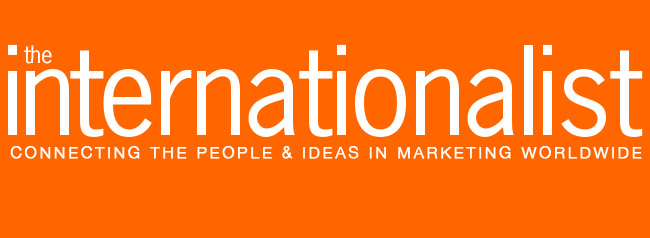

Doug Wood
See the current issue
of The Internationalist magazine
Find out how to sponsor an issue of Trendsetters
|
|
If you have spotted a trend or given a recent presentation on a global issue, please tell us and don't forget a photo of yourself!

To submit to Trendsetters, contact me at: linkedin.com/in/deborah-malone-ab5897,
The Internationalist group on LinkedIn:
https://www.linkedin.com/groups/2560753/or at Twitter--@DMaloneIntl
TRENDSETTERS: Doug Wood Tackles the Year of the Tiger by Outlining What Lies Ahead for Brands
The Internationalist Trendsetters is written by Deborah Malone, founder of The Internationalist.
"As 2022 – the Year of the Tiger – comes roaring in, it's that time to speculate once again on what lies ahead for marketers," says Doug Wood. "So, here's the top ten trends and challenges I see (in no particular order) that if unheeded may make brands the next endangered species (assuming they are not already)."
Doug Wood has practiced law for 45 years with a concentration in advertising and marketing. He is a Senior Counsel at Reed Smith and serves as General Counsel to the ANA and MMA Global (formerly the Mobile Marketing Association), while advising major brands throughout the world.
If you'd like to listen to a podcast about his 2022 trends and legal challenges for advertisers—which range from the Murky World of the Metaverseto COVID Hangover to Section 230 Blues, CLICK HERE
1. Programmatic Continues to Muddy the Waters
As brands, like lemmings, pump billions more into reaching consumers through algorithms rather than good old-fashioned marketing, will they know if their dollars reach a human being capable of buying their products and services or vanish in the ether? The answer is not likely. But there is some good news in 2022 that will at least help brands put up a good fight against the technology underworld.
The Association of National Advertisers will be releasing the third iteration of its media buying contract template. Many brands have used past versions and the next one will address the complexities associated with programmatic in practical ways. It remains to be seen how the supply chain will react. If the past is a precursor to the future, players in the stream will come up with new ideas to disguise waste as a legitimate ROI.
On a related front, expect to see the results of the latest investigation by the ANA led by a powerhouse team of PwC, Kroll, and TAG Trustnet to reveal where and how the waste dilutes investments from the brand to the consumer. While past studies have looked at the process from brands to publishers, this new effort will trace the dollar from the brand to the consumer – the human consumer. It's safe to predict that the results will open many eyes to how programmatic is a cash cow for middlemen who skim pennies here and dollars there until the effective reach of ad dollars is shown to be far worse than traditional media. Will that stem the love affair with programmatic? Will brands be brave enough to say enough is enough? Will publishers ally with brands to keep more dollars for themselves? Or will bots and obfuscation by suppliers continue to thwart legitimate measures of success?
Other tools in the shed for brands are audits and reviews. Audits are embedded in all media contracts. But those who ply their expertise in programmatic make audits difficult with excuses that diminish transparency and accountability. More battle lines will be drawn in 2022 as audits continue.
At the same time, new RFPs will demand that transparency and accountability be part of the conditions to win the business. Experience teaches us that the RFP stage is where brands have the leverage necessary to insure as much protection for their ad investments as possible. In 2022, they have to get tougher and not allow suppliers to defer responsibilities to properly marshal brand investment – and shareholder equity.
2. The Mysterious and Murky World of Blockchain, the Metaverse and NFT's
Will blockchain and distributed ledgers break out in 2022? Will brands continue to dip their toes into the Metaverse? Perhaps. But both are still years away from becoming robust marketing tools for brands. That doesn't mean brands won't continue to dabble in avatars and virtual worlds. Every smart marketer needs to consider the new world since that's where consumers are going. But the Matrix is still as imaginary today as it was in 1999 when the blockbuster movie debuted.
Millions of dollars are being spent by purportedly savvy buyers on NFTs – non-fungible tokens. A digital file created by Beeple, a heretofore relatively unknown artist, was auctioned by Christies for more than $60 million. He followed that sale with another NFT that looks like an astronaut that sold for nearly $30 million. Nice work if you can get it. Other NFTs by artists, entertainers, and musicians have likewise sold for millions. Now brands are finding ways to monetize their intellectual property through NFTs. According to Ad Age, Anheuser-Busch will use them to promote Budweiser, the GAP will sell them as collectibles, and Animal Planet will be using them in this year's pre-SuperBowl celebration. The Budweiser NFTs will sell for $499 each, the GAP tokens will go for $8.30, and the lovable digital toys from Animal Planet will be free. So expect to see a lot more of them in promotions and at retail. Good investments? Maybe. Maybe not. But a once relatively unknown artist became a multimillionaire selling a couple of NFTs. So, who knows what branded NFTs will bring us in 2022?
3. Window Shopping from the Comfort of Window PC's
Window shopping used to be a pleasurable way to spend some time on Main Street and in shopping malls exercising and gazing at things we might want to buy. When the pandemic hit, we were suddenly housebound and our wanderlust to visit stores and showrooms was crushed in an instant. So we turned to on-line – e-tail – for some comfort from imprisonment. In 2022, will malls return to their once vaunted glory? Not if digital, and consumer addiction to it, has its way.
In 2022, keep an eye on retail media networks (RMNs) or "digital storefronts," alliances of off-line and online retailers and brands. For brands and digital sellers, it's a win-win. As my colleague, Keri Bruce, describes it, retailers who have both brick and mortar and online store fronts can monetize their 1st party data by allowing third parties (such as the brands that sells products in their stores) to advertise to the retailer's customers both on and off the retailer e-commerce site. This gives the retailers a new revenue stream and for brands, it allows them to better target purchase intent. Also, for brands that sell their products in the retailer's stores, it could lead to better product placement in the store. The platforms monetize their space, and the brands have an effective and measurable way to invest ad dollars that might otherwise go into the black hole of programmatic. An example is the Netflix hub on walmart.com. This "store within a store" concept is common in brick-and-mortar venues and is now appearing on digital platforms.
As viable as this new approach may be to gain sales, there's another less publicized reason brands are flocking to the format. Data. Creating their own first party data from customers who opt into their RMN offerings. It's an alternative to cookies, the entry ticket to third party data.
Why? Because accumulating and exploiting first party data is far less regulated than dealing with third party data. With privacy laws becoming increasingly complex, brands are looking at digital options to avoid the fate of the Titanic for what they can't see below the waves of privacy regulations. RMNs are an example. But regulators are watching and consumer concern about using personal information is rising, so brands need to be cautious as they sail in these icy waters.
4. Big Brother -- Privacy and Data at the State and Global Level
2022 is going to look a lot like 1984, at least the way George Orwell looked at it. Data is king. And the most valuable data today is your personal identifiable information, so-called PII. It's not just marketers who covet it. So do governments and scammers. Some governments, like China, make it quite clear that they want PII to monitor and control behavior. To spy on both their citizens and foreigners who do business in their country. Other countries are not as open about their motives, but it's all pretty much for the same purposes.
Scammers want your PII to steal your money, exploit your identity and ransom your database servers.
Brands, the innocents in the mix, just want it to sell you something. Yet consumers and regulators view such manipulation as capitalistic avarice and want to deny brands access to PII. The soon to be demise of cookies is a consequence of that hysteria. So, brands need to start preparing for a cookie-less world. They say they know that, but what are they doing to ensure targeted marketing isn't lost in the mix? Brands better get it done in 2022.
Meanwhile, efforts to enact a federal law to make some sense out of the parameters within which brands can use PII have faltered and the likelihood of seeing Congress step in with a solution is about as likely as Nancy Pelosi and Mitch McConnell celebrating Thanksgiving together.
To fill the void, states are stepping in with a patchwork of conflicting laws that create a nightmare for brands. California's law is complex enough and other states, like Virginia, are crafting their own versions. Hopefully, we'll see some effective tools in 2022 to deal with that maze.
Global marketers will continue to be haunted by the GDPR and complications expected as an unintended consequence of Brexit. What will the UK do about privacy regulation? We really don't know yet. So stay tuned.
5. Death and Taxes
Contrary to the adage that you can't avoid death and taxes, the advertising industry has been successful in avoiding taxes on ads for decades. In 1987, Florida tried to extract an ad tax from brands only to see an exodus of sponsored events from the state. The law was repealed, and Disney World was saved. The battles with states continued with victory after victory killing any tax proposals. The ANA and other associations that helped deserve a place in the Advertising Hall of Fame. But times have changed, and Maryland now has an ad tax. Unfortunately, not a lot of brands rush to host events in Maryland so the threat to its economy, like that which forced Florida to back off, is not likely to cause any panic among Maryland's legislators. If Maryland's ad tax stands, 2022 may well become a bellwether year where other cash strapped states follow Maryland's lead. Literally billions are at stake.
6. Brands for Humans
Sustainability and protection of the environment, diversity and inclusion, brand safety, and more will be a mantra for brands in 2022. The focus on social responsibility – brands with a purpose – will continue to mature as market leaders set examples others will follow. It's more than just ad content. Packaging, product formulae, distribution chains, and supplier accountability will all be part of the goals. Contracts and ad content will increasingly focus on them. Expect some brands to trip as their environmental claims get too aggressive, but the industry will continue to play an important role in improving the world in which their customers live and thrive.
7. Uncle Sam Wants [to Control] You
In 2021, the Federal Trade Commission had it wings clipped by the Supreme Court when the Justices shot down some of the Commission's injunctive and financial remedies. It even shocked some in the House of Representatives. In a rare moment when House members took a break from infighting, they passed a law to restore and expand the FTC's powers. The Senate has yet to follow suit. Unwilling to wait for Congressional help, the FTC isn't standing down and has begun using both old and new weapons in its arsenal to attack marketing practices it deems improper. In 2022, brands may well see a lot more FTC oversight despite the slap on the wrist from the Supreme Court and lethargy in Congress.
At the same time, the wildcard for marketers in 2022 is the Federal Communications Commission as it takes a more active look at the entire broadcast and broadband world. In its sights are social media platforms upon which brands rely to find consumers.
8. Section 230 Blues
Could there be more debate over a simple statute? Both sides of the aisle are demanding changes to Section 230 of the Communications Decency Act, a federal law some say allows social media platforms and digital marketers get away with virtual murder. This dark knight of the Internet reads, "No provider or user of an interactive computer service shall be treated as the publisher or speaker of any information provided by another information content provider." Put more simply, a social media platform is not responsible for what someone else posts. The problem is that traditional publishers, like the New York Times, do not enjoy such immunity. And a lot of what is posted is reprehensible, false, and downright dangerous.
But despite all the clamor, don't expect Congress to make any significant changes with midterm elections just months away. It's highly unlikely we'll see any bipartisan leadership in addressing the problem. So brands will continue to be plagued with threats to brand safety when their ads appear adjacent to objectionable content.
In 2022, look for brands to step in and try to solve the problem with self-regulation. They've already set standards through the Global Alliance for Responsible Media (GARM), an alliance of associations and brands working with social media platforms to ensure ads do not monetize false and harmful content injurious to the good will of brands. Unfortunately, as we enter 2022, brands will continue to have sleepless nights worrying about their ads appearing next to Nazi propaganda.
9. Actors Take the Stage
The collective bargaining agreement with SAG-AFTRA for commercials expires on March 31, 2022. Stacy Marcus, the Chief Negotiator for The Joint Policy Committee (JPC), a coalition of the ANA and 4A's, will lead the advertising industry in negotiating an agreement that the industry hopes will transform the existing outdated, complicated structure to modernize and realign the contract with current and future industry trends. As always, the JPC will do its best to keep the industry informed throughout the process, and hopes to deliver a deal that satisfies both performers and the advertising industry. In 2022, brands need to follow the JPC's lead and heed its advice.
10. Living with the COVID Hangover
If we remember nothing, we'll remember that 2022 marks the third year we've been plagued by the pandemic. And consumers are tired of it. But it's not going away. Brands will continue to be challenged by remote working, Zoom overload, and closeted consumers addicted to TikTok and telling one another what they had for lunch. So live events will continue to have mixed results and face cancellations as one variant or another rears its ugly head. Brands cannot let their guards down and contracts have to be ready for disruption. Like it or not, we are now living the new normal despite pundits telling us otherwise. So, brands need to embrace it and find innovative ways to reach their consumers and support their workers and suppliers. That may be the biggest challenge to growth faced by marketers in 2022. The winning brands will be those that innovate and invigorate.
